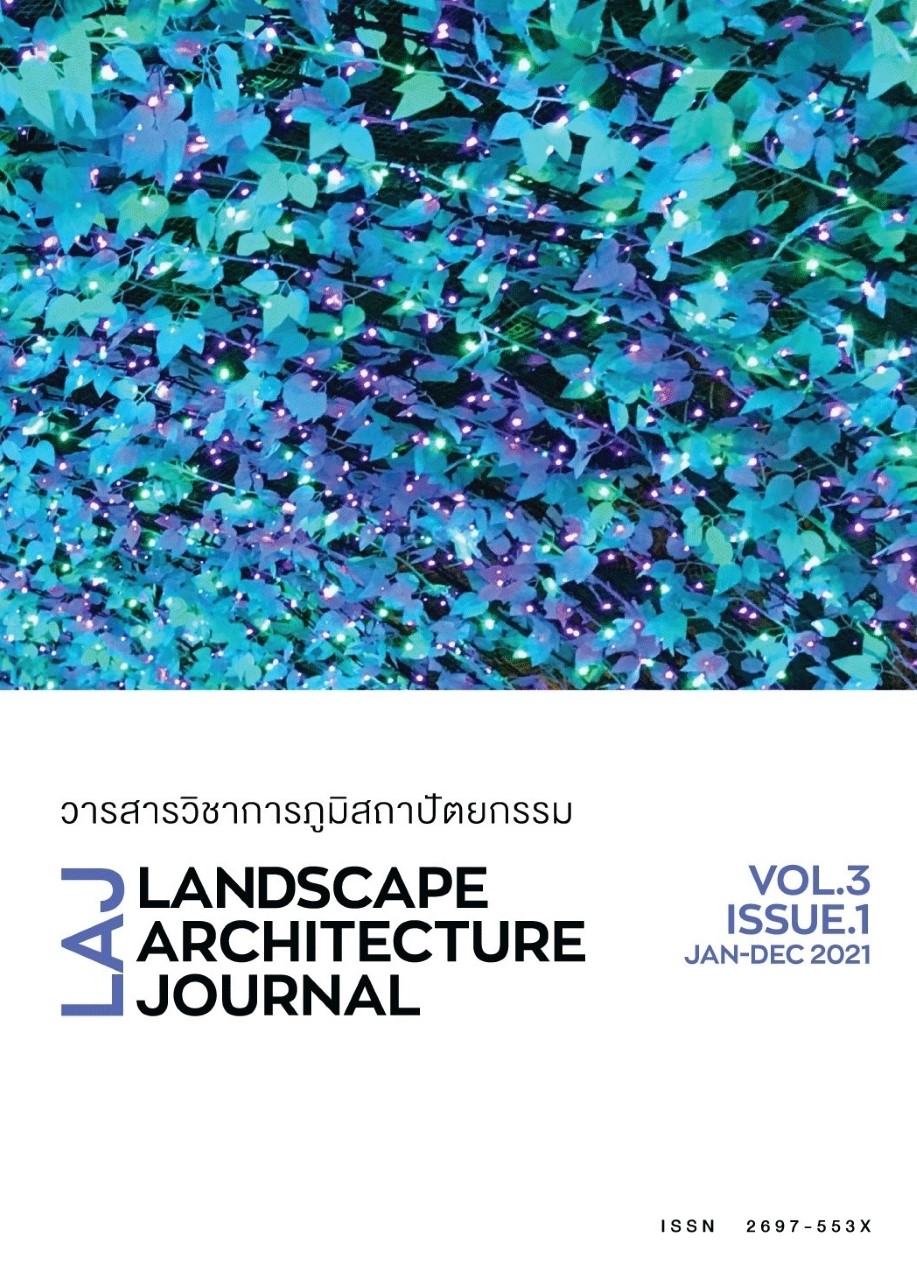A Study of Space Allocation in the Landscape Architecture of Four and Five Star Resort Hotels in Northern Thailand
Main Article Content
Abstract
The knowledge and skills in landscape architectural design and planning of resort hotels are important for landscape architects, students, and related organizations to develop landscape architecture design programs and allocate functional space properly. In this study, 9 four and five star resort hotels in the northern region of Thailand (Thai Hotels Association, 2020) were used as case studies. This research was intended to study various aspects of the resort hotels in detail. The resulting data were then analyzed to find their relationships leading to the conclusions and recommendations for the development of similar type projects. The research process started with collecting secondary data from various documents and primary data from surveys. The collected data were analyzed to find the conclusion. The results showed that important factors affected the early stages of program development of the four and five star resort hotels in the northern region including the forms of management and the physical environment of the project sites. They influenced the size of the hotel which was classified by the number of rooms, and the size of the hotel. The physical environment of most resort hotel studied (77.78 percent) are in urban areas on flat lands with easy access to main road. They have provided beautiful distant or close-up views. Most of them are located along the river. There were some resort hotels (22.22 percent) located in suburban areas with outstanding natural environment characteristics. To develop the programs of hotel amenities, factors that must have been taken into account including the proportion of different types of hotel rooms, the hotel service standards (star ratings), and the hotel size classified by number of rooms. For the large hotel group with a large number of rooms, the ratio of the number of suites to the number of single rooms was lower, compared to that of the smaller hotel group with fewer rooms. In planning the use areas of the hotels, the layout of the hotel rooms could be divided into 4 types: U-shaped or V-shaped layout, Central court layout, Linear layout and Centralized layout, by taking into consideration the view from the guest rooms of the resort hotels and from other areas within the hotel, both settings and natural sceneries. The design and layout of the entry ways and parking took into account the connection with the main road and the size of the hotel areas. The facilities and the green areas’ location depended on the layout of the hotel grounds and activities that took place in the resorts. As for the designation of natural green spaces, it also depended on the original natural features of the project areas. The results of this research would benefit both landscape architects, project owners, faculty members, academics and students in the program development of resort hotel projects in northern Thailand to be consistent with the reality in the regional hospitality market.
Article Details

This work is licensed under a Creative Commons Attribution-NonCommercial-NoDerivatives 4.0 International License.
References
กรมการท่องเที่ยว. (2557ก). มาตรฐานการท่องเที่ยวไทย : มาตรฐานที่พักเพื่อการท่องเที่ยว เล่มที่ 1 ประเภทสถานพักตากอากาศ รีสอร์ท ระดับ 5 ดาว. สำนักงานกิจการโรงพิมพ์องค์การสงเคราะห์ทหารผ่านศึก.
กรมการท่องเที่ยว. (2557ข). มาตรฐานการท่องเที่ยวไทย : มาตรฐานที่พักเพื่อการท่องเที่ยว เล่มที่ 2 ประเภทสถานพักตากอากาศ รีสอร์ท ระดับ 1-4 ดาว. สำนักงานกิจการโรงพิมพ์องค์การสงเคราะห์ทหารผ่านศึก.
นตธชา รัตนเพียร, รุจิรา เจริญสวัสดิ์, และสมรพรรณ คงสกุล. (2559). ปัจจัยที่มีผลต่อการเลือกพักแรมของนักท่องเที่ยวในการพัฒนาการท่องเที่ยวอย่างยั่งยืน จังหวัดเชียงใหม่. วารสารวิชาการมหาวิทยาลัยรัตนบัณฑิต. 11 (1), 25–34.
พชรพจน์ นันทรามาศ, กิตติพงษ์ เรือนทิพย์, และจารุวรรณ เหล่าสัมฤทธิ์. (2563). เจาะพฤติกรรมท่องเที่ยวใน New Normal: เมื่อโควิดทำชีวิตเปลี่ยน. สืบค้นจาก https://krungthai.com/Download/economyresources/EconomyResources Download _450เจาะพฤติกรรมท่องเที่ยวใน_New_Normal_เมื่อโควิดทำชีวิตเปลี่ยน_31_31_08_63.pdf.
วิเชียร เจนตระกูลโรจน์, อนุชา แพ่งเกสร, และอัฏฐมา บุญปาลิต. (2560). แนวทางการออกแบบรีสอร์ทที่เป็นมิตรกับสิ่งแวดล้อม. วารสารวิชาการ Veridian E – Journal สาขามนุษยศาสตร์สังคมศาสตร์และศิลปะ. 10 (3), 2641-2652.
ศรัญญา สรรพมิตร, และศิวฤทธิ์ สุนทรเสณี. (2563). พฤติกรรมการท่องเที่ยวของนักท่องเที่ยวในจังหวดเชียงใหม่. การประชุมนําเสนอผลงานวิจัยระดับบัณฑิตศึกษามหาวิทยาลัยรังสิตครั้งที่ 15 ปีการศึกษา 2563, มหาวิทยาลัยรังสิต, ปทุมธานี.
สมาคมโรงแรมไทย. (2562). รายชื่อโรงแรม/รีสอร์ท ที่ได้รับการรับรองมาตรฐานที่พักเพื่อการท่องเที่ยว. สืบค้นจาก https://www.thaihotels.org/16750781/รายชื่อโรงแรมที่ได้รับการรับรองมาตรฐานที่พักเพื่อการท่องเที่ยว.
สุริวัสสา นารินคำ, สุดสันต์ สุทธิพิศาล, และเฉลิมเกียรติ เฟื่องแก้ว. (2557). พฤติกรรมและรูปแบบของนักท่องเที่ยวชาวต่างชาติ ในจังหวัดเชียงราย. วารสารวิทยาการจัดการ มหาวิทยาลัยราชภัฎเชียงราย, 9 (1): 61–79.
deRoos, J. A. (2011). Planning and programming a hotel. In M. C. Sturman, J. B. Corgel, & R. Verma (Eds.), The Cornell School of Hotel Administration on hospitality: Cutting edge thinking and practice (pp. 321-332). Wiley.
Ernst & Young. (2003). Resorting to Profitability. Sydney: Tourism Task Force (TTF) Australia.
Kasavana, M. L. & Brooks, R. M. (2009) Managing Front Office Operations. (8th ed.). American Hotel & Lodging Association.
Mill, R. C. (2011). Resorts: Management and Operation, (3rd ed.). John Wiley & Sons.

